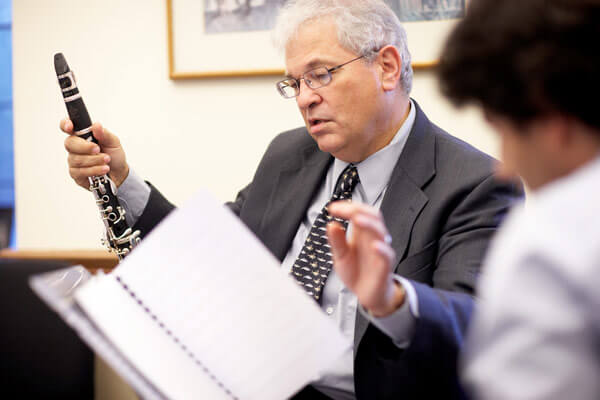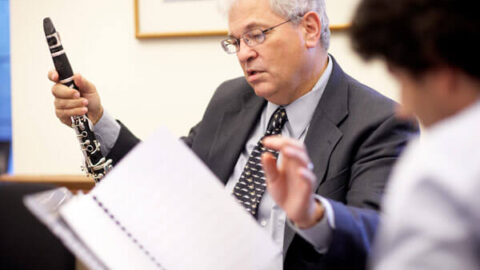Rob Wendt asked 5 questions to David Shifrin (clarinetist, artistic director) about the legacy of Paul Hindemith—a member of the YSM faculty 1940-1953—and the central idea of a Carnegie Hall concert happening tomorrow, Friday, November 22, as part of the Yale in New York series. Indeed, the concert will feature music by Hindemith and several of his Yale students, including Alvin Etler, Lukas Foss, Mitch Leigh, Mel Powell, and Yehudi Wyner.
David Shifrin, welcome back to New York! The playful and inventive Op. 24 Kammermusik pieces (1922) date from well before Hindemith’s time at Yale, and yet they sound very ahead of their time, anticipating the later work of composers like Roger Sessions. Still in his twenties, the composer could not have known he would one day expatriate himself from Germany. How do these youthful compositions fit in with Hindemith’s overall legacy?
I have to confess that the selection of this work to open our program is a somewhat personal one. In my experience as a young clarinet student, Hindemith’s Kleine Kammermusik was among the most often studied and performed woodwind chamber music works. It almost defines the medium of the woodwind quintet. Stylistically and architecturally, it is near perfect, combining jazzy rhythms, expressive harmonies, amazing colors both blending and contrasting orchestration of the five diverse wind instruments.

Among Hindemith’s students at Yale were the accomplished jazz artists Mel Powell and Willie Ruff. I have encountered some harmonies in the composer’s piano sonatas that I felt could definitely be analyzed in jazz terms. Is there a conscious convergence between jazz and classical idioms in Hindemith’s music and pedagogy? Is there any evidence he ever studied the adventurous harmonies of Monk and Ellington?
Hindemith’s early career included stints playing in theatres and clubs, and writing jazz-influenced music. I think this is fairly evident in his Kammermusik #1, with its driving rhythms and adventurous instrumentation, harmonies and special effects.
Mel Powell’s Woodwind Quintet is full of short, distinct phrases, like much of Hindemith’s music for winds. The exclamatory, angular outbursts from flute and clarinet seem right out of the troubled dreams of birds. Although the tonal palette is wide, it’s not quite serial. How did Hindemith’s students resist the pull of the post-war 12-tone bandwagon?… or, did they?
Mel Powell enjoyed multiple “personas” as a great jazz pianist, arranger and as composer. Some of his earlier chamber works were modeled on Hindemith’s more “conservative” harmonic style (his earlier Divertimenti for Woodwind quintet, for instance.) The Woodwind quintet from 1986 is a different story all together. There are dodecaphonic and aleatoric elements that combine to make this very individual and fascinating study in the sounds a wind quintet can achieve.
Lukas Foss’s “Three American Pieces” almost sound more influenced by Satie’s Gymnopédies than by any Hindemith work I know of! The title begs the question: to what extent were Hindemith’s students on this side of the pond looking to establish a uniquely American art music idiom? Did he encourage their “rugged individualism” or was he a conservative, old-world taskmaster?
Looking at the diverse backgrounds and interests of Hindemith’s protégés I think the answer is both. Hindemith surely helped each develop creatively while helping them develop the tools and techniques to write music of such varied style. Certainly Lukas Foss’s compositions embraced a very broad spectrum of influence from throughout time and place and beyond the influence of a single teacher or school.
Alvin Etler’s “Suite for Flute, Oboe and Clarinet” demonstrates that these delicate timbres can exhibit pulse and propulsion. The piece shares with Hindemith’s rhythmic language a sense of measure, and discernible subdivisions of the beat. Meanwhile (mid-century), at the Darmstadt Ferienkurse in Hindemith’s native Germany, composers like Boulez and Stockhausen were experimenting with much more elastic temporal phenomena. Are we to consider the Hindemith school as fundamentally conservative?
Though he had a distinct voice of his own, Alvin Etler’s music can arguably be described as being closer in style to his teacher’s than many of Hindemiths other students. Wind and brass players in particular owe a great deal to Etler for enriching our repertoire. This is not a big surprse considering he was the conductor of the Yale band and an superb oboist.
























